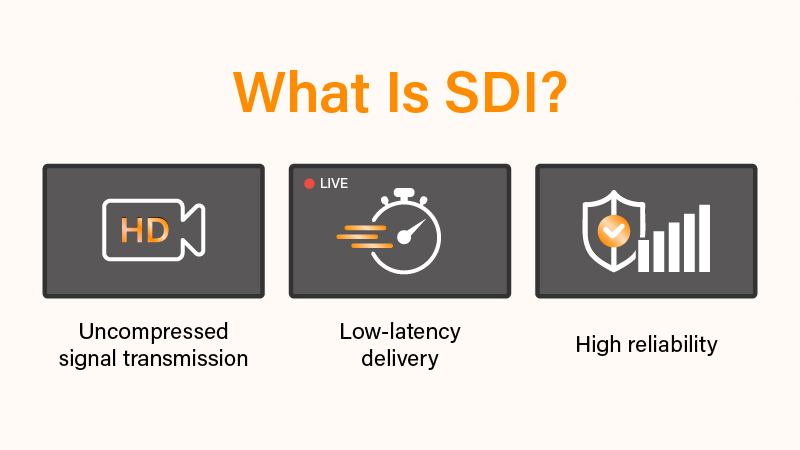


In the world of professional broadcasting, precision is non-negotiable. Cameras must deliver frame-accurate video. Transmission must be instantaneous. It was in this high-stakes environment that SDI—Serial Digital Interface—first gained prominence. Originally designed to support uncompressed, low-latency video over coaxial cables, SDI quickly earned its place as a broadcast standard.
But today, SDI’s influence reaches far beyond the studio. It has quietly become a critical backbone of real-time video surveillance in mission-sensitive environments—places where every second matters and failure is not an option. Whether in hospitals, transport terminals, or industrial facilities, SDI has found a new role: empowering security teams with reliability, speed, and clarity.
SDI (Serial Digital Interface) is a digital video transmission standard that delivers uncompressed, high-definition video over coaxial cables using BNC connectors. Originally developed for professional broadcasting, SDI enables near-zero latency video transmission, making it ideal for real-time surveillance applications where speed, clarity, and reliability are critical.
Defined by the SMPTE standard, SDI transmits digital video signals over 75-ohm coaxial cables, ensuring stable, lossless performance. In surveillance, the two most commonly used formats are HD-SDI, which supports 1080p resolution at 30 frames per second, and 3G-SDI, which doubles that frame rate to 60 fps with a bandwidth of 2.97 Gbps. These formats are widely adopted across commercial-grade surveillance monitors and cameras, offering plug-and-play connectivity and seamless live viewing with no need for network configuration.
While IP-based video systems have become increasingly popular, especially in cloud-connected and enterprise-wide installations, they aren’t always the most reliable choice in every surveillance context. In fact, many sites still depend on SDI as a stable, low-maintenance alternative—particularly where real-time visibility, coaxial infrastructure, or limited IT resources come into play.
Transport terminals, for example, rely on SDI to provide live platform video directly to control rooms without network bottlenecks. In healthcare settings, SDI offers a secure video path across isolated or segmented networks where IT policy restricts additional bandwidth use. And in factories, warehouses, or industrial compounds, many facilities retain existing coaxial cabling that SDI supports natively—eliminating the need for costly rewiring or system overhauls.
By transmitting video directly from camera to monitor, SDI allows faster on-site decision-making, removes dependencies on local area networks, and simplifies deployment. It also reduces the number of failure points found in software-managed systems, helping integrators and security teams build more predictable, resilient installations.
For more on SDI’s performance advantages, see our article on low-latency monitoring.
A common misconception is that surveillance projects must choose between SDI or IP video. In reality, the two can coexist. Many modern systems are hybrid by design, leveraging SDI where latency and simplicity are essential, while utilising IP cameras for remote access, video storage, and cloud integration. To understand how SDI delivers real-time clarity in field deployments, read our article on why low latency still matters in surveillance.
This hybrid approach is especially valuable in scenarios that demand both on-site responsiveness and centralized management. For instance, platform staff at a train station might monitor live feeds via SDI, while the security headquarters uses IP-based tools for recording and analysis. With this division of roles, SDI becomes a vital front-line tool, complementing the broader capabilities of networked surveillance.
The practical advantages of SDI are most visible in high-traffic, high-stakes, or hard-to-wire environments. In transit hubs, SDI monitors provide real-time visual feedback of public areas, ensuring that station staff can act on potential threats immediately. Emergency departments and hospital entrances use SDI to guarantee visual access to incoming situations, even when their internal networks are segmented for data security.
In the logistics sector, SDI is a reliable choice for monitoring activity at loading bays and corridors where network signals may be weak or intermittent. And in remote facilities—such as border outposts or temporary construction zones—SDI’s ability to operate independently of local network infrastructure makes it invaluable for maintaining surveillance continuity.
Once you’re familiar with SDI technology, learn how to choose the right SDI monitor for your specific application.
As surveillance needs evolve, so too has SDI display technology. Today’s commercial-grade SDI monitors are engineered not just for compatibility, but for continuous operation in the toughest conditions. Many support both Full HD and 4K input, offer loop-through BNC output for cascading displays, and feature durable metal housings that withstand round-the-clock use.
For system integrators, these monitors reduce installation time, eliminate complex software configuration, and integrate seamlessly into coaxial environments. Whether for a new deployment or an upgrade within an existing SDI infrastructure, the benefits are immediate: clear visuals, dependable uptime, and faster rollout.
SDI may have started in broadcasting, but its legacy lives on in video surveillance for one simple reason—it works. In critical locations where every frame counts and delay is unacceptable, SDI provides the assurance of clarity without compromise. It allows teams to focus on what matters most—protecting people, assets, and infrastructure—without second-guessing their video feed.
For those building surveillance systems in mission-critical spaces, SDI is more than just a signal format. It’s a strategic choice for operational reliability. With AG Neovo’s portfolio of SDI monitors—ranging from compact displays to large-format screens with loop-out capability—you’ll have the tools you need to meet today’s surveillance challenges head-on.